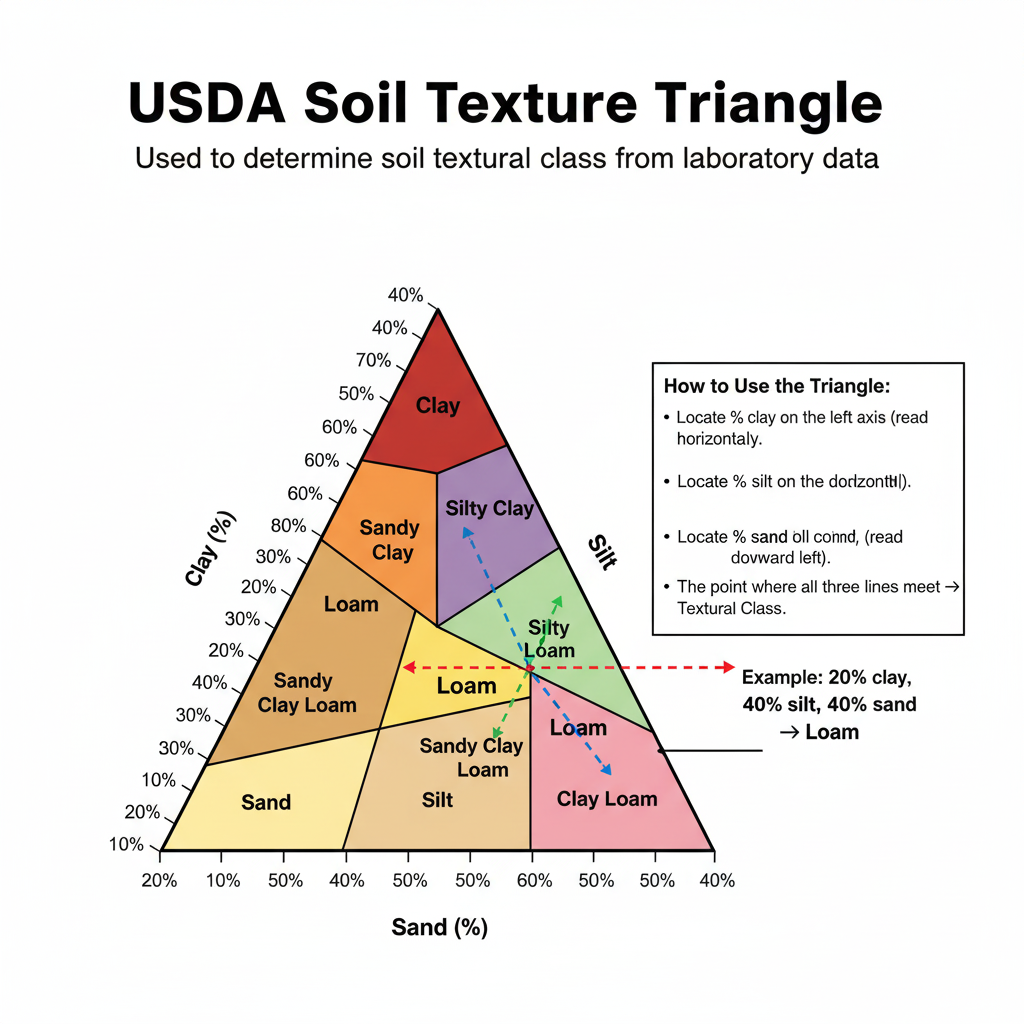Soil Texture
- Introduction
- Soil texture refers to the relative proportion of different-sized mineral particles — namely sand, silt, and clay — in a soil.
- It is one of the most basic and permanent physical properties of soil.
- Texture affects water holding capacity, aeration, tillage, nutrient retention, and plant growth.
- Definition; Soil texture is the relative proportion of sand, silt, and clay particles present in a soil, which determines the coarseness or fineness of the soil.
- Soil Separates (According to USDA and ICAR Classification)
|
Soil Separate |
Diameter (mm) |
Feel |
Behavior in Water |
|
Sand |
2.0 – 0.05 |
Gritty |
Rapid drainage, poor nutrient retention |
|
Silt |
0.05 – 0.002 |
Smooth, floury |
Holds moderate water and nutrients |
|
Clay |
< 0.002 |
Sticky, plastic |
High nutrient & water-holding capacity, poor drainage |
Note: ICAR and USDA systems use the same particle size limits for soil separates. These separates make up the mineral fraction of the soil.
- Soil Textural Classes
Based on the percentage of sand, silt, and clay, soils are classified into 12 standard textural classes (as per the USDA Soil Texture Triangle).
|
Group |
Textural Class |
Characteristics |
|
Coarse Textured Soils |
Sand, Loamy Sand |
Large particles, low water-holding, high aeration |
|
Moderately Coarse |
Sandy Loam |
Better water-holding, easy to till |
|
Medium Textured Soils |
Loam, Silt Loam, Silt |
Balanced texture, ideal for cultivation |
|
Moderately Fine |
Clay Loam, Silty Clay Loam |
Good nutrient retention, moderate drainage |
|
Fine Textured Soils |
Clay, Silty Clay |
High CEC, sticky, poor drainage, difficult tillage |
- Soil Texture Triangle
- The USDA Texture Triangle is used to determine soil textural class from laboratory data.
- It shows the percentages of sand, silt, and clay intersecting to form 12 classes.

- Methods of Determining Soil Texture
|
Method |
Basis |
Description |
|
1. Feel Method |
Sense of touch |
Rubbing moist soil between fingers (used in field) |
|
2. Mechanical Analysis |
Particle size separation |
Based on Stokes’ Law using sedimentation/hydrometer method |
|
3. Pippette Method |
Laboratory method |
More accurate; measures settling rates of particles |
Stokes’ Law
The rate of fall of soil particles in water is proportional to the square of their diameter (used in hydrometer method).
- Properties Influenced by Soil Texture
|
Property |
Effect of Coarse Texture (Sandy) |
Effect of Fine Texture (Clayey) |
|
Water holding capacity |
Low |
High |
|
Drainage & Aeration |
Excellent |
Poor |
|
Nutrient retention |
Low |
High |
|
Temperature |
Warms up quickly |
Warms up slowly |
|
Tillage |
Easy |
Difficult (sticky when wet) |
|
Erosion hazard |
Low (if coarse) |
High (if fine, when bare) |
Practical Importance of Soil Texture
- Determines Water Movement and Storage: Fine soils → hold more water but less available to plants. Coarse soils → drain quickly.
- Affects Soil Fertility: Clayey soils have higher CEC and nutrient storage.
- Influences Tillage and Seedbed Preparation: Sandy soils → easier to cultivate. Clay soils → require careful management.
- Determines Suitability for Crops: Rice prefers clayey soils (water retention). Groundnut prefers sandy loam (good drainage).
- Affects Erosion and Conservation Measures: Fine soils → prone to erosion; need contouring/mulching.
Texture vs. Structure
|
Aspect |
Texture |
Structure |
|
Definition |
Relative proportion of sand, silt, clay |
Arrangement of soil particles into aggregates |
|
Changeability |
Permanent property |
Can be changed by management |
|
Determined by |
Particle size |
Organic matter, tillage, roots |
|
Example |
Sandy loam |
Granular, blocky, platy |
- Examples of Common Soil Textures in India
|
Region / State |
Dominant Texture |
Soil Type |
|
Indo-Gangetic Plains |
Loam to clay loam |
Alluvial soils |
|
Central India |
Clayey |
Black cotton (Regur) soils |
|
Rajasthan Desert |
Sandy |
Arid soils |
|
Coastal Areas |
Sandy loam |
Coastal alluvium |
|
Deccan Plateau |
Clay loam |
Red and lateritic soils |

